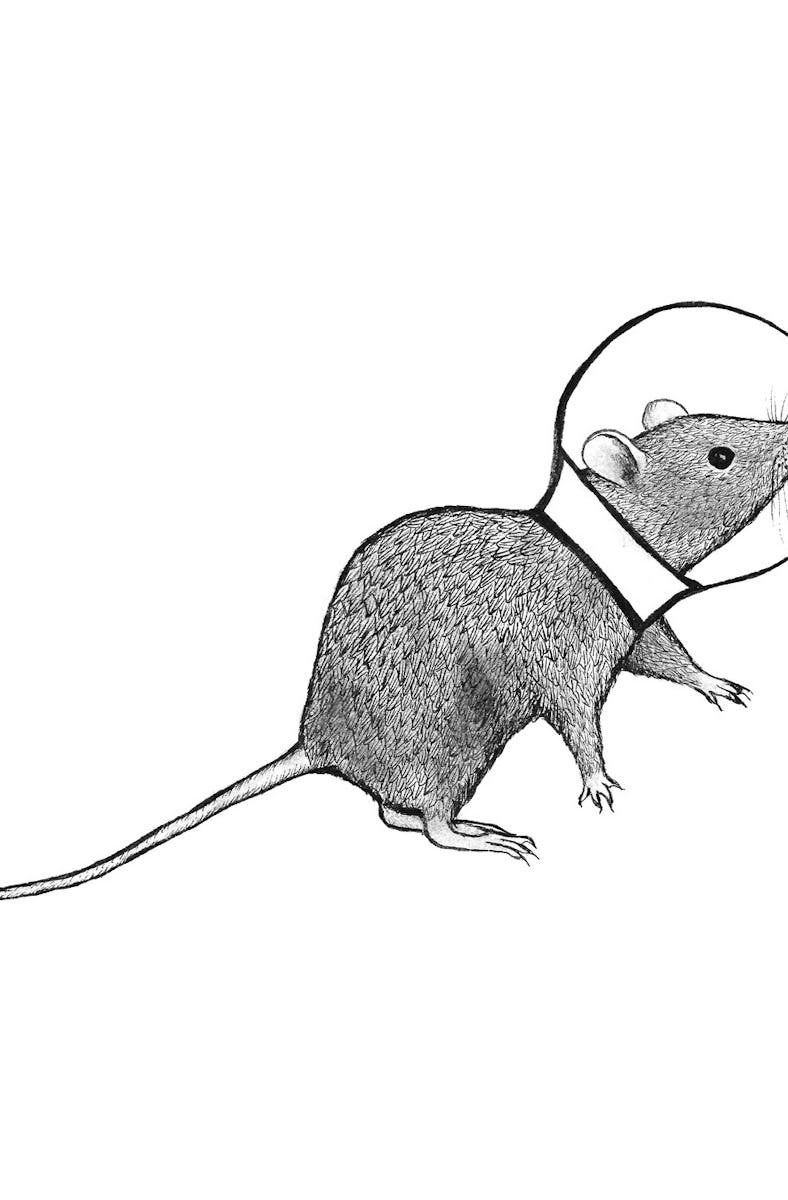Astronaut Mice Reveal Potential Link Between the Gut and Bone Loss in Space
Is it “moustronaut,” or “astromouse?”

Adventure Mouse is a literary genre unto itself. From Mickey Mouse to Despereaux, fictional rodents are known to ride motorcycles, battle witches, and be charming sidekicks. But their real-life counterparts might have them beat: Moustronauts (or astromice, if you will) — rodents that have made the trip to space — have been instrumental to science.
These mice act as proxies for future astronauts, showing us the effects of living in microgravity, an environment with little to no gravity. Microgravity has been known to affect astronauts’ health in myriad ways. It can disrupt circadian rhythm, cause eye issues, and impact muscle mass and bone density. Notably, astronauts lose 1 to 2 percent of their bone density every month they’re in space. Moreover, microgravity likely disrupts the gut microbiome, which is the host of microbes thriving in our digestive tract. The gut impacts other biological functions like the immune system, which means spaceflight can indirectly alter other processes by changing our guts.
One of the latest studies on mice in space, published in the journal Cell on April 19, examines bone density linked with the gut microbiome. After spending one or two months on the International Space Station (ISS), results from 20 mice revealed how guts, bones, and microgravity could make for an unexpected trio in the realm of spaceflight.
The tale of RR-5
Rodent Research 5, or RR-5, is the NASA mission that sent 20 courageous rodents to the ISS in the name of science. Ten of these mice spent a total of two months at the ISS, while the other ten returned to Earth alive after just one month and then spent another month reacclimating to life on their home planet. A control group of 20 mice spent the duration on Earth living in identical conditions, minus microgravity.
To the study authors’ surprise, the space-bound members of RR-5 had increased levels of two bacteria strains in their gut microbiomes, Lactobacillus murinus, and Dorea species. These bacteria are linked with the process of adjusting the body’s skeletal integrity, known as bone remodeling. This may mean there’s a link between gut bacteria, bone loss, and the effects of microgravity on the body. They were abundant in the group that returned to Earth after one month and even more so in the group that spent two months on the ISS.
“This is the beauty of science,” senior author Wenyuan Shi, a microbiologist and chief executive officer at the Forsyth Institute, tells Inverse. “We never predicted those results.”
While the researchers can’t establish any cause among these observations, they were still surprised.
“We had no idea that this was coming,” says first author Joe Bedree, who completed this study as a microbiology research fellow at the Forsyth Institute. Bedree now works as a strain engineer and synthetic biologist at tech startup Invaio Sciences.
Feeling it in your gut and your bones
Time spent in space does a number on the body. Astronauts, Bedree says, must weightlift for several hours a day to maintain muscle mass and bone density. As humans continue to explore the cosmos, we’ll need to know what’s in store for our fragile bodies.
“As we traverse into deeper space, it's important to understand all of these different health effects and how we can mitigate them to keep astronauts healthy,” Bedree tells Inverse.
Mouse space studies also lend credibility to understanding how microgravity alters biological processes. Lab rodents can be engineered to have identical genomes, whereas NASA has to wait for the good fortune of finding identical twin astronauts. Genetic variability between humans makes it difficult to study the effects of spaceflight since there are too many factors at play.
But this research isn’t only useful for those of us pursuing the final frontier. Shi says this insight on the gut microbiome and bone remodeling has implications for understanding bone loss and osteoporosis in humans who live out their days on Earth.
Microbiome in microgravity
Shi says that at first glance, it looked like the gut microbiome hadn’t changed after being in microgravity. “Initially, we were a little disappointed,” he tells Inverse, until his team clocked two strains of bacteria that were “relatively unknown.” As the team dove into understanding this modest bacteria with whole genome sequencing, they saw these strains generated short-chain fatty acids, the primary metabolites produced in the gut, which indirectly affect bone metabolism.
“That's where the ‘a-ha’ moment got started,” Shi says.
In particular, the short-chain fatty acids lactate and malate appeared at higher levels in the spaceflight group. Human astronauts, it turned out, also had higher levels of lactate and malate, indicating that there was indeed something significant about these short-chain fatty acids and microgravity. For now, the authors hypothesize that this increase may indirectly influence bone remodeling.
Still, Bedree cautions that correlation and causation are different things. Simply observing these bacteria that produce metabolites relating to the bone doesn’t mean that microgravity causes them to crop up. The increased numbers of these bacteria could be a consequence of adapting to microgravity, or perhaps these mice were trying to compensate for the bone loss by changing their gut microbiome. Ultimately, this data is observational for now.
The excitement of the unknown
That said, this study splinters into many more potential studies. Bedree says the next big question is whether the proliferation of these bacteria is bad or good news for the gut microbiome host. In either case, NASA will have to take that information and adjust astronaut preparation accordingly, either promoting or killing off those bacteria.
Or, researchers could dive further into these observed bacteria. Shi says they may want to better understand the molecular mechanism at play.
“That's part of the excitement, right?” Bedree says “And it's creating avenues for future exploration.”
This article was originally published on